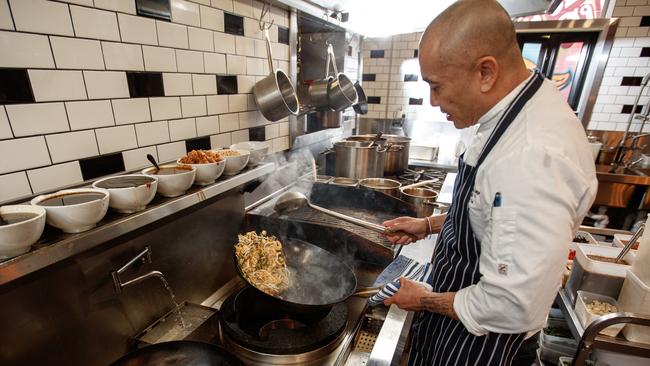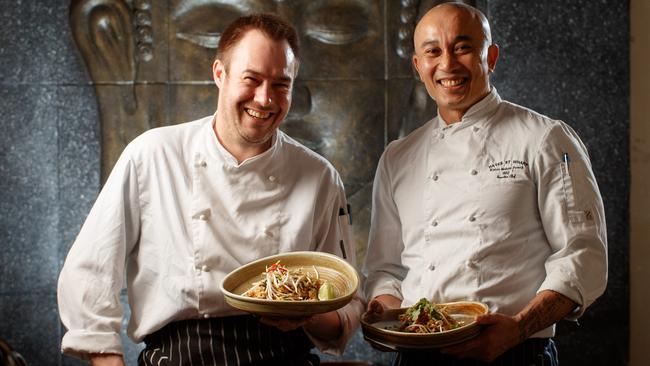How to create the perfect pad thai — a guide with Nu Suandokmai from Lantern by Nu
PAD thai is one of the world’s great street foods but with help from the team at Lantern by Nu it can become a favourite at home as well.
IT’S a dish that is quick and convenient, a favourite of many families and unquestionably one of the world’s great street foods. But pad thai, scholars say, also played a role in the history of the country in which it was invented. It’s not too big a stretch to says that this is the dish that helped shape a nation.
While it has now spread across the globe in a similar way to pizza or sushi, the origins of pad thai go back only to the 1930s.
The story goes that then prime minister Field Marshal Plaek Phibunsongkhram, desperate to stop his country being colonised (and also to hang on to power himself), developed a series of edicts to promote national pride.
One of these was changing the name Siam to Thailand. Another was to eat only Thai food. A competition was run to develop a new national dish and the winner was pad thai. The government promoted it up and down the country, supplying restaurants with the recipe and even handing over free street carts.
Now pad thai is cooked in homes all over the country, as well as being a staple on
the streets.
“It is a street food but also cooked in a restaurant where they sometimes make it fancy by wrapping it in an egg net or omelet,” explains Nu Suandokmai, owner/chef at Lantern by Nu, the magical Thai restaurant and bar hidden in a small laneway just west of Chinatown.

“On the street it is cheap (sometimes less than $1) and cooked in a big, flat pan, like paella. They can cook 40 to 50 serves. It is hotter in the middle, so the cooked noodles can be moved to the outside.”
Nu says noodles came to Thailand from China but the Thai people had “made them their own” with the sweet, sour and salty flavours they loved.
They were a regular meal for his family when growing up on a farm north of Bangkok, he says, and the recipe he uses at Lantern is based on his mum’s.
Watch Nu cooking pad thai at the restaurant on a powerful wok burner and it is over in a few frantic minutes of hissing heat and flashes of the spatula.
The dish uses comparatively few ingredients and relies on being cooked at speed. However, Nu and his friend and wingman in the kitchen at Lantern, Peter Westfield, have a wealth of knowledge to share that can take your noodles to the next level.

HOT SPOT
The biggest trap for the home cook is trying to cook too much at once. The ordinary wok burner on a stove or barbecue doesn’t have the firepower of commercial equipment. The secret, Peter says, is to do a little at a time, so the noodles can still pick up some of the smoky, lightly scorched aroma known as “the breath of the wok”.
“If I was cooking for two people, I would cook two pad thais,” Peter says. “And it can
be quicker, as well. When you throw in too many noodles it all slows down and stews and takes longer.
“With this kind of food, one portion doesn’t take much time as long as all the prep is done. And it doesn’t have to be smoking hot out of the wok when you eat it.”
THE SAUCE
While it is possible to make (or buy) a pre-mixed sauce, it will never be as good as adding the individual components, so the flavours can be adjusted.
“The balance of sweet and sour flavours can change each time,” Peter says. “And if a premix sauce is kept in the fridge for a few days, the flavour can deteriorate.”
Nu’s basic ratios are simple: three tablespoons of tamarind and fish sauce, and two of
white sugar.

SWEET AND SOUR
When it comes to tamarind, both chefs agree that the commercial bottle or jar of puree is nothing like making your own. They recommend buying a compressed block of dried pulp and seeds, available at most Asian grocers. This can be soaked in warm water, if you are in a rush, and then pushed through a sieve with the back of a large spoon.
“But it is easier if you can put the pulp in cold water the day before you need it,” Peter advises. “And by the time you want to use it, it has become really pliable.
“It makes a huge difference. You are not rushing and you don’t have to force it through the sieve so much.
“It is really important to massage the meat out of the seeds. Get your hands dirty
and make a mess.”
For a 375g block of tamarind, soak in about 1.5 litres of water. The resulting puree will keep for at least a week in the fridge when made this way.
Using hot water can start the fermentation process, meaning it will be spoiled in a few days.
USE YOUR NOODLE
Even more important for your pad thai planning is to soak the noodles ahead of time.
A traditional pad thai uses a dried rice noodle, or rice stick noodle, widely available in supermarkets and other stores.
“You need to soak the noodles overnight or at least for a few hours in cold water,” Peter says. “You can’t rush it and definitely don’t use hot water. If you do try a short cut, the noodles will be nutty in the middle and overcooked on the outside. If it was me and I forgot to soak the noodles, I would actually change the dish.”

MEAT OR VEG
The street hawkers of Thailand will most often make their pad thai without fresh meat or seafood, using egg, firm tofu and dried shrimp as the protein.
At Lantern by Nu, the noodles often include fresh prawns or slices of chicken
meat — or both.
Whatever the case, the protein should be introduced at the beginning of the cooking time.
Dried shrimp can be added whole if they are very small but Nu prefers to use a slightly larger size and blitz them to a rough powder in a blender.
ON THE SIDE
Another ingredient never found in a pad thai is chilli — fresh or dried. Rather, dried chilli powder is served in a little heap alongside the noodles as an accompaniment that can be added to taste (or left out altogether).
To make the powder, Nu buys packets of dried chillies that are 4-5cm long. They are roasted in bulk and then repackaged, ready for use.
“Roasting them again adds a whole new dimension,” Peter says. “It brings a different, earthy roastiness to the chilli.”
Smaller chillies will be hotter but they do vary, so check the flavour. The same-sized chilli grown in Australia is nowhere near as hot as one grown in Thailand, Peter says.
OIL CHANGE
Nu uses canola or mixed vegetable oil for stir-frying. Peanut oil, he says, is expensive and also causes issues for people with allergies.
READY, SET, GO
Even in the home kitchen, cooking a serve of pad thai shouldn’t take more than five minutes. Everything happens quickly so it is important to have all ingredients ready to go and within reach of the wok.
Heat the oil until it is shimmering before adding the protein ingredients. If cooking chicken thigh, this should go in first or, preferably, be fried and then removed.
An egg is broken straight into the bottom of the wok and gently scrambled so it forms an omelet with yellow and white still showing.
“It’s a slow scramble,” Nu says. “Break it up a little, look at it but don’t totally demolish like a normal scrambled egg.”
“And you want some scorch marks on it … not burn marks … for that smoky flavour,”
Peter adds.
Then the noodles go in and, depending on the heat of your burner, you might turn the temperature down. Cook the noodles until they soften — “a little bit of tshhh, tshhh”, Peter says — for about 30 seconds.
Then add the sauces, dried shrimp, turnip and some of the peanuts.
Continue cooking until the sauce caramelises and takes on a lovely deep brown colour. Finally, add the bean sprouts and garlic chives.
Taste to make sure the noodles are tender and the balance of the sauces is right.

NO NOODLES HERE
Lantern by Nu also makes an alternative pad thai, swapping the noodles for the shredded heart of green papaya in the dish “Malagor pad thai” found on the specials board.
The fruit is amazing when cooked, retaining a tempting bite and amplifying the flavours of the sauce in a way that is different to the rice noodles.
“In Thailand, it is another way of using the papaya when it is in season and the trees are full of fruit,” Nu says.
WHERE TO SHOP
Nu and Peter buy many of their Thai ingredients from the Asian grocers around the Central Market, particularly the larger Kim Wang. “For the stuff that is hard to find, I go to the grocers in Parafield Gardens,” Nu says.
“They have fresh fish and everything.”
● Kim Wang Asian Grocery, Market Plaza, 61-63 Grote St, city, 8410 1555
● World Asian Grocery Store, 24 Catalina Ave, Parafield Gardens, 8258 5198
● Martin’s Plaza Asian Grocery, 237 Martins Rd, Parafield Gardens, 8182 3555
Lantern by Nu, 10 Selby St, city,
7078 3559

SECRET INGREDIENTS
1. Sold as either pickled turnip or preserved radish, this little pack of fermented veg gives the pad thai a giant wallop of flavour. “It’s sweet, salty and sour,” Peter says, “and full of umami. It’s a flavour enhancer in itself.”
The pickle is made from daikon and available in both salty and sweet versions — make sure to get the latter.
2. Coriander haters, rejoice: A proper pad thai will not contain coriander, except perhaps as a garnish. Instead, the herb of choice is garlic chive, a slender-bladed green leaf that resembles cut grass, available at Asian groceries.
“They are absolutely essential for the dish,” Peter says.
“They create a background flavour that you can’t replicate with anything else.”
Lantern by Nu pad thai
Serves 1-2
2 tbsp vegetable oil
150g chicken breast, thinly sliced and/or prawns
50g hard tofu, cut into small dice
1 egg
50g eschalot (red or golden), thinly sliced
150g soaked rice noodles or shaved green papaya
3 tbsp fish sauce
3 tbsp tamarind puree
2 tbsp white sugar
10g dried shrimp
10g sweet pickled turnip
50g crushed unsalted peanuts plus extra, to serve
20g garlic chives, sliced into short lengths
20g bean sprouts, to garnish
Lime wedges, to serve
Driedchillies,crushed,toserve
1 Heat oil in a wok until shimmering. Add proteins of choice and carefully break egg into oil. Wok fry until the egg is set and meat has colour, scraping with ladle or spatula so nothing sticks to the bottom.
2 Add noodles or papaya and stir-fry for 1-2 minutes. Add all other ingredients down to the peanuts, and toss in the wok until slightly caramelised. Taste and adjust the flavour. This may take 2-5 minutes, depending on the strength of your wok.
3 Add garlic chives and stir through. Taste the noodles for balance and plate up garnished with fresh bean sprouts, dried chillies, fresh lime wedges and extra peanuts.
Note: Nu uses 3mm rice noodles.

